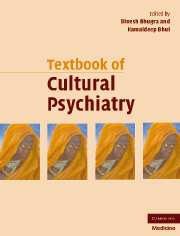Book contents
- Frontmatter
- Contents
- Contributors
- Foreword
- Preface
- Part I Theoretical background
- Part II Culture and mental health
- Part III Culture and mental disorders
- 15 Neurosis
- 16 Schizophrenia and related psychoses
- 17 Affective disorders
- 18 Substance misuse
- 19 Culture and mental disorders: suicidal behaviour
- 20 Personality disorders and culture
- 21 Culture and obsessive-compulsive disorder
- 22 Culture and eating disorders
- 23 Childhood and adolescent psychiatric disorders
- 24 Culture and schizophrenia
- 25 Disorders of ageing across cultures
- Part IV Theoretical aspects of management
- Part V Management with special groups
- Part VI Cultural research and training
- Cultural psychiatry: the past and the future
- Index
- References
22 - Culture and eating disorders
from Part III - Culture and mental disorders
Published online by Cambridge University Press: 11 August 2009
- Frontmatter
- Contents
- Contributors
- Foreword
- Preface
- Part I Theoretical background
- Part II Culture and mental health
- Part III Culture and mental disorders
- 15 Neurosis
- 16 Schizophrenia and related psychoses
- 17 Affective disorders
- 18 Substance misuse
- 19 Culture and mental disorders: suicidal behaviour
- 20 Personality disorders and culture
- 21 Culture and obsessive-compulsive disorder
- 22 Culture and eating disorders
- 23 Childhood and adolescent psychiatric disorders
- 24 Culture and schizophrenia
- 25 Disorders of ageing across cultures
- Part IV Theoretical aspects of management
- Part V Management with special groups
- Part VI Cultural research and training
- Cultural psychiatry: the past and the future
- Index
- References
Summary
EDITORS' INTRODUCTION
Although eating disorders have been described historically, they have often been seen as Western ‘culture-bound’ syndromes. There are, however, occasional case reports beginning to emerge from different cultures across the globe. The prevalence studies of eating disorders in low income countries have initially demonstrated lower than expected rates and if disordered eating patterns exist these do not reach diagnostic categories of illness levels. Furthermore, as eating disorders are generally more reported among females, the gender roles and gender-role expectations would vary across cultures. In cultures where the female is seen as a vessel for procreation, the identity of the female would be different from cultures where females have equal rights to males.
In this chapter Nasser emphasizes the nature of the eating disorder syndrome and its merging with prevalent and culturally acceptable eating behaviours which call for an interpretation grounded in the culture. The cultivation of the body ideal and promotion of thinness values in certain subcultural groups and the impact of fashion, media and diet industry put the female under a tremendous amount of pressure. The increased prevalence in the female, in the urban settings with increased social mobility and changes within family structures, also plays a role. She argues that the culture boundedness/specificity of eating pathology stood first on the assumption that societal mandates regarding thinness were rooted in Western cultural values and conflict. However, in the last decade or so, studies from different parts of the world have indicated that eating disorders are beginning to emerge in these societies.
- Type
- Chapter
- Information
- Textbook of Cultural Psychiatry , pp. 292 - 300Publisher: Cambridge University PressPrint publication year: 2007
References
- 2
- Cited by



